Novel Visible Light-Driven Ho2InSbO7/Ag3PO4 Photocatalyst for Efficient Oxytetracycline Contaminant Degradation
Abstract
1. Introduction
2. Results and Discussion
2.1. Characterization of Photocatalysts
2.2. Examination of Photocatalytic Efficiency
2.2.1. Photocatalytic Degradation of OTC
2.2.2. Comparison of Photocatalytic Activity
2.2.3. Possible Photocatalytic Mechanism of HAO
2.2.4. Possible Degradation Pathway of OTC
3. Experimental Section
3.1. Materials and Reagents
3.2. Synthesis of N-Doped TiO2
3.3. Preparation Method of Ho2InSbO7
3.4. Synthesis of HAO Heterojunction Photocatalyst
3.5. Characterization
3.6. Photoelectrochemical Experiments
3.7. Experimental Setup and Procedure
4. Conclusions
Supplementary Materials
Author Contributions
Funding
Institutional Review Board Statement
Informed Consent Statement
Data Availability Statement
Conflicts of Interest
References
- Polianciuc, S.I.; Gurzau, A.E.; Kiss, B.; Stefan, M.G.; Loghin, F. Antibiotics in the environment: Causes and consequences. Med. Pharm. Rep. 2020, 93, 231–240. [Google Scholar] [CrossRef]
- Low, C.X.; Tan, L.T.-H.; Ab Mutalib, N.-S.; Pusparajah, P.; Goh, B.-H.; Chan, K.-G.; Letchumanan, V.; Lee, L.-H. Unveiling the Impact of Antibiotics and Alternative Methods for Animal Husbandry: A Review. Antibiotics 2021, 10, 578. [Google Scholar] [CrossRef]
- Li, Z.J.; Qi, W.N.; Feng, Y.; Liu, Y.W.; Ebrahim, S.; Long, J. Degradation mechanisms of oxytetracycline in the environment. J. Integr. Agric. 2019, 18, 1953–1960. [Google Scholar] [CrossRef]
- Leal, J.F.; Santos, E.B.H.; Esteves, V.I. Oxytetracycline in intensive aquaculture: Water quality during and after its administration, environmental fate, toxicity and bacterial resistance. Rev. Aquac. 2019, 11, 1176–1194. [Google Scholar] [CrossRef]
- Li, X.; Zhao, X.; Chen, Z.L.; Shen, J.M.; Jiang, F.; Wang, X.C.; Kang, J. Isolation of oxytetracycline-degrading bacteria and its application in improving the removal performance of aerobic granular sludge. J. Environ. Manag. 2020, 272, 111115. [Google Scholar] [CrossRef]
- Lee, Y.-J.; Lee, J.-M.; Lee, C.-G.; Park, S.-J.; Jho, E.H. Photodegradation Behavior of Agricultural Antibiotic Oxytetracycline in Water. Water 2022, 14, 3379. [Google Scholar] [CrossRef]
- Senasu, T.; Youngme, S.; Hemavibool, K.; Nanan, S. Sunlight-driven photodegradation of oxytetracycline antibiotic by BiVO4 photocatalyst. J. Solid State Chem. 2021, 297, 122088. [Google Scholar] [CrossRef]
- Pelosato, R.; Bolognino, I.; Fontana, F.; Sora, I.N. Applications of Heterogeneous Photocatalysis to the Degradation of Oxytetracycline in Water: A Review. Molecules 2022, 27, 2743. [Google Scholar] [CrossRef] [PubMed]
- Li, C.J.; Zhang, D.H.; Peng, J.L.; Li, X.G. The effect of pH, nitrate, iron (III) and bicarbonate on photodegradation of oxytetracycline in aqueous solution. J. Photochem. Photobiol. A Chem. 2018, 356, 239–247. [Google Scholar] [CrossRef]
- Liu, Y.Q.; He, X.X.; Fu, Y.S.; Dionysiou, D.D. Degradation kinetics and mechanism of oxytetracycline by hydroxyl radical-based advanced oxidation processes. Chem. Eng. J. 2016, 284, 1317–1327. [Google Scholar] [CrossRef]
- Nguyen, C.H.; Tran, T.T.V.; Tran, M.L.; Juang, R.-S. Facile synthesis of reusable Ag/TiO2 composites for efficient removal of antibiotic oxytetracycline under UV and solar light irradiation. J. Taiwan Inst. Chem. Eng. 2023, 145, 104825. [Google Scholar] [CrossRef]
- Jin, X.; Xu, H.Z.; Qiu, S.S.; Jia, M.Y.; Wang, F.; Zhang, A.Q.; Jiang, X. Direct photolysis of oxytetracycline: Influence of initial concentration, pH and temperature. J. Photochem. Photobiol. A Chem. 2017, 332, 224–231. [Google Scholar] [CrossRef]
- He, H.B.; Liang, B.L.; Lin, S.M.; Chen, Y.; Zhang, X.; Liang, S.X. Photodegradation of oxytetracycline hydrochloride by Z-scheme g-C3N4 @MIL-101(Fe) heterojunction: Experimental optimization, mechanism evaluation and practical application. J. Environ. Chem. Eng. 2024, 12, 112018. [Google Scholar] [CrossRef]
- Liu, H.; Wang, C.Y.; Wang, G.X. Photocatalytic Advanced Oxidation Processes for Water Treatment: Recent Advances and Perspective. Chem.-Asian J. 2020, 15, 3239–3253. [Google Scholar] [CrossRef] [PubMed]
- Akerdi, A.G.; Bahrami, S.H. Application of heterogeneous nano-semiconductors for photocatalytic advanced oxidation of organic compounds: A review. J. Environ. Chem. Eng. 2019, 7, 103283. [Google Scholar] [CrossRef]
- Saddique, Z.; Imran, M.; Javaid, A.; Latif, S.; Hussain, N.; Kowal, P.; Boczkaj, G. Band engineering of BiOBr based materials for photocatalytic wastewater treatment via advanced oxidation processes (AOPs)—A review. Water Resour. Ind. 2023, 29, 100211. [Google Scholar] [CrossRef]
- Gao, B.; Dong, S.; Liu, J.; Liu, L.; Feng, Q.; Tan, N.; Liu, T.; Bo, L.; Wang, L. Identification of intermediates and transformation pathways derived from photocatalytic degradation of five antibiotics on ZnIn2S4. Chem. Eng. J. 2016, 304, 826–840. [Google Scholar] [CrossRef]
- Chakhtouna, H.; Benzeid, H.; Zari, N.; Qaiss, A.e.k.; Bouhfid, R. Recent progress on Ag/TiO2 photocatalysts: Photocatalytic and bactericidal behaviors. Environ. Sci. Pollut. Res. 2021, 28, 44638–44666. [Google Scholar] [CrossRef] [PubMed]
- Lai, C.; Zhang, M.M.; Li, B.S.; Huang, D.L.; Zeng, G.M.; Qin, L.; Liu, X.G.; Yi, H.; Cheng, M.; Li, L.; et al. Fabrication of CuS/BiVO4 (040) binary heterojunction photocatalysts with enhanced photocatalytic activity for Ciprofloxacin degradation and mechanism insight. Chem. Eng. J. 2019, 358, 891–902. [Google Scholar] [CrossRef]
- Xu, J.W.; Xi, R.; Xu, X.L.; Zhang, Y.; Feng, X.H.; Fang, X.Z.; Wang, X. A2B2O7 pyrochlore compounds: A category of potential materials for clean energy and environment protection catalysis. J. Rare Earths 2020, 38, 840–849. [Google Scholar] [CrossRef]
- Luan, J.F.; Li, Y.Y. Photocatalytic Water Splitting for Hydrogen Production with Gd2MSbO7 (M = Fe, In, Y) Photocatalysts under Visible Light Irradiation. Materials 2015, 8, 16–30. [Google Scholar] [CrossRef]
- Li, J.H.; Han, M.S.; Guo, Y.; Wang, F.; Sun, C. Fabrication of FeVO4/Fe2TiO5 composite catalyst and photocatalytic removal of norfloxacin. Chem. Eng. J. 2016, 298, 300–308. [Google Scholar] [CrossRef]
- Yao, Y.; Luan, J.F. Preparation, Property Characterization of Gd2YSbO7/ZnBiNbO5 Heterojunction Photocatalyst for Photocatalytic Degradation of Benzotriazole under Visible Light Irradiation. Catalysts 2022, 12, 159. [Google Scholar] [CrossRef]
- Adhikari, S.; Mandal, S.; Kim, D.-H. Z-scheme 2D/1D MoS2 nanosheet-decorated Ag2Mo2O7 microrods for efficient catalytic oxidation of levofloxacin. Chem. Eng. J. 2019, 373, 31–43. [Google Scholar] [CrossRef]
- Hao, L.; Luan, J.F. Constructing Direct Z-Scheme Y2TmSbO7/GdYBiNbO7 Heterojunction Photocatalyst with Enhanced Photocatalytic Degradation of Acetochlor under Visible Light Irradiation. Int. J. Mol. Sci. 2024, 25, 6871. [Google Scholar] [CrossRef] [PubMed]
- Li, Y.-F.; Zhong, Y.; Chang, J.-Q.; Hu, C.-H. Synthesis and effects on visible light photocatalytic activity of Bi2Ti2O7 photocatalyst. IOP Conf. Ser. Mater. Sci. Eng. 2018, 307, 012041. [Google Scholar] [CrossRef]
- Zou, Z.G.; Ye, J.H.; Arakawa, H. Growth, photophysical and structural properties of Bi2InNbO7. J. Cryst. Growth 2001, 229, 462–466. [Google Scholar] [CrossRef]
- Cai, H.S.; Liu, G.G.; Lue, W.Y.; Li, X.X.; Yu, L.; Li, D.G. Effect of Ho-doping on photocatalytic activity of nanosized TiO2 catalyst. J. Rare Earths 2008, 26, 71–75. [Google Scholar] [CrossRef]
- Zimbone, M.; Cacciato, G.; Spitaleri, L.; Egdell, R.G.; Grimaldi, M.G.; Gulino, A. Sb-Doped Titanium Oxide: A Rationale for Its Photocatalytic Activity for Environmental Remediation. Acs Omega 2018, 3, 11270–11277. [Google Scholar] [CrossRef]
- Low, J.X.; Yu, J.G.; Jaroniec, M.; Wageh, S.; Al-Ghamdi, A.A. Heterojunction Photocatalysts. Adv. Mater. 2017, 29, 1601694. [Google Scholar] [CrossRef] [PubMed]
- Yang, H. A short review on heterojunction photocatalysts: Carrier transfer behavior and photocatalytic mechanisms. Mater. Res. Bull. 2021, 142, 111406. [Google Scholar] [CrossRef]
- Gnanaguru, M.V.L.; Parida, V.K.; Ghangrekar, M.M.; Gupta, A.K.; Chowdhury, S. Insights into the performance of binary heterojunction photocatalysts for degradation of refractory pollutants. Environ. Sci. Pollut. Res. 2024, 31, 11349–11370. [Google Scholar] [CrossRef]
- Che, H.N.; Chen, J.B.; Huang, K.; Hu, W.; Hu, H.; Liu, X.T.; Che, G.B.; Liu, C.B.; Shi, W.D. Construction of SrTiO3/Bi2O3 heterojunction towards to improved separation efficiency of charge carriers and photocatalytic activity under visible light. J. Alloys Compd. 2016, 688, 882–890. [Google Scholar] [CrossRef]
- Lu, C.Y.; Guo, F.; Yan, Q.Z.; Zhang, Z.J.; Li, D.; Wang, L.P.; Zhou, Y.H. Hydrothermal synthesis of type II ZnIn2S4/BiPO4 heterojunction photocatalyst with dandelion-like microflower structure for enhanced photocatalytic degradation of tetracycline under simulated solar light. J. Alloys Compd. 2019, 811, 151976. [Google Scholar] [CrossRef]
- Bognár, S.; Jovanovic, D.; Putnik, P.; Despotovic, V.; Ivetic, T.; Bajac, B.; Tóth, E.; Fincur, N.; Maksimovic, I.; Putnik-Delic, M.; et al. Solar-driven removal of selected organics with binary ZnO based nanomaterials from aquatic environment: Chemometric and toxicological assessments on wheat. J. Environ. Chem. Eng. 2024, 12, 112016. [Google Scholar] [CrossRef]
- San Martín, S.; Rivero, M.J.; Ortiz, I. Unravelling the Mechanisms that Drive the Performance of Photocatalytic Hydrogen Production. Catalysts 2020, 10, 901. [Google Scholar] [CrossRef]
- Guo, Y.; Li, J.H.; Gao, Z.Q.; Zhu, X.; Liu, Y.; Wei, Z.B.; Zhao, W.; Sun, C. A simple and effective method for fabricating novel p-n heterojunction photocatalyst g-C3N4/Bi4Ti3O12 and its photocatalytic performances. Appl. Catal. B Environ. 2016, 192, 57–71. [Google Scholar] [CrossRef]
- Pal, S.; Maiti, S.; Maiti, U.N.; Chattopadhyay, K.K. Low temperature solution processed ZnO/CuO heterojunction photocatalyst for visible light induced photo-degradation of organic pollutants. Crystengcomm 2015, 17, 1464–1476. [Google Scholar] [CrossRef]
- Qian, X.Y.; Ma, Y.; Arif, M.; Xia, J.W.; He, G.Y.; Chen, H.Q. Construction of 2D/2D Bi4O5Br2/Bi2WO6 Z-scheme heterojunction for highly efficient photodegradation of ciprofloxacin under visible light. Sep. Purif. Technol. 2023, 316, 123794. [Google Scholar] [CrossRef]
- Hu, X.C.; Wang, G.H.; Wang, J.; Hu, Z.F.; Su, Y.R. Step-scheme NiO/BiOI heterojunction photocatalyst for rhodamine photodegradation. Appl. Surf. Sci. 2020, 511, 145499. [Google Scholar] [CrossRef]
- Costa, T.M.S.; Lima, M.S.; Cruz Filho, J.F.; Silva, L.J.; Santos, R.S.; Luz, G.E., Jr. Synthesis, characterization, and photocatalytic activity of Ag3PO4/SBA-15 in ciprofloxacin degradation under polychromatic irradiation. J. Photochem. Photobiol. A Chem. 2018, 364, 461–471. [Google Scholar] [CrossRef]
- Al Kausor, M.; Sen Gupta, S.; Chakrabortty, D. Ag3PO4-based nanocomposites and their applications in photodegradation of toxic organic dye contaminated wastewater: Review on material design to performance enhancement. J. Saudi Chem. Soc. 2020, 24, 20–41. [Google Scholar] [CrossRef]
- Ma, X.; Lu, B.; Li, D.; Shi, R.; Pan, C.; Zhu, Y. Origin of Photocatalytic Activation of Silver Orthophosphate from First-Principles. J. Phys. Chem. C 2011, 115, 4680–4687. [Google Scholar] [CrossRef]
- Zhu, P.F.; Duan, M.; Wang, R.X.; Xu, J.; Zou, P.; Jia, H.S. Facile synthesis of ZnO/GO/Ag3PO4 heterojunction photocatalyst with excellent photodegradation activity for tetracycline hydrochloride under visible light. Colloids Surf. A Physicochem. Eng. Asp. 2020, 602, 125118. [Google Scholar] [CrossRef]
- Zhang, H.S.; Yu, D.; Wang, W.; Gao, P.; Bu, K.X.; Zhang, L.S.; Zhong, S.; Liu, B.J. Multiple heterojunction system of Bi2MoO6/WO3/Ag3PO4 with enhanced visible-light photocatalytic performance towards dye degradation. Adv. Powder Technol. 2019, 30, 1910–1919. [Google Scholar] [CrossRef]
- Wang, J.H.; Zou, Z.G.; Ye, J.H. Synthesis, structure and photocatalytic property of a new hydrogen evolving photocatalyst Bi2InTaO7. In Functionally Graded Materials VII; Pan, W., Gong, J., Zhang, L., Chen, L., Eds.; Scientific.Net: Bäch, Switzerland, 2003; Volume 423, pp. 485–490. [Google Scholar]
- Kudo, A.; Kato, H.; Nakagawa, S. Water splitting into H2 and O2 on new Sr2M2O7 (M = Nb and Ta) photocatalysts with layered perovskite structures: Factors affecting the photocatalytic activity. J. Phys. Chem. B 2000, 104, 571–575. [Google Scholar] [CrossRef]
- Kaviyarasu, K.; Sajan, D.; Devarajan, P.A. A rapid and versatile method for solvothermal synthesis of Sb2O3 nanocrystals under mild conditions. Appl. Nanosci. 2013, 3, 529–533. [Google Scholar] [CrossRef]
- Mortazavi-Derazkola, S.; Salavati-Niasari, M.; Amiri, O.; Abbasi, A. Fabrication and characterization of Fe3O4@SiO2@TiO2@Ho nanostructures as a novel and highly efficient photocatalyst for degradation of organic pollution. J. Energy Chem. 2017, 26, 17–23. [Google Scholar] [CrossRef]
- Panneerdoss, I.J.; Jeyakumar, S.J.; Ramalingam, S.; Jothibas, M. Characterization of prepared In2O3 thin films: The FT-IR, FT-Raman, UV-Visible investigation and optical analysis. Spectrochim. Acta Part A Mol. Biomol. Spectrosc. 2015, 147, 1–13. [Google Scholar] [CrossRef]
- Rada, S.; Rus, L.; Rada, M.; Zagrai, M.; Culea, E.; Rusu, T. Compositional dependence of structure, optical and electrochemical properties of antimony(III) oxide doped lead glasses and vitroceramics. Ceram. Int. 2014, 40, 15711–15716. [Google Scholar] [CrossRef]
- Chai, B.; Li, J.; Xu, Q. Reduced Graphene Oxide Grafted Ag3PO4 Composites with Efficient Photocatalytic Activity under Visible-Light Irradiation. Ind. Eng. Chem. Res. 2014, 53, 8744–8752. [Google Scholar] [CrossRef]
- Kumar, R.S.; Priyanka, K.H.S.; Khanra, A.K.; Johnson, R. A novel approach of synthesizing nano Y2O3 powders for the fabrication of submicron IR transparent ceramics. Ceram. Int. 2021, 47, 16986–16999. [Google Scholar] [CrossRef]
- Gilliam, S.J.; Jensen, J.O.; Banerjee, A.; Zeroka, D.; Kirkby, S.J.; Merrow, C.N. A theoretical and experimental study of Sb4O6: Vibrational analysis, infrared, and Raman spectra. Spectrochim. Acta Part A Mol. Biomol. Spectrosc. 2004, 60, 425–434. [Google Scholar] [CrossRef]
- Mohamed, H.E.A.; Khalil, A.T.; Hkiri, K.; Ayaz, M.; Usman, A.; Sadiq, A.; Ullah, F.; Hussain, I.; Maaza, M. Phyto-fabrication of ultrafine nanoscale holmium oxide HT-Ho2O3 NPs and their biomedical potential. Rsc Adv. 2023, 13, 27912–27922. [Google Scholar] [CrossRef] [PubMed]
- Saenze, S.; Gurlo, A.; Hess, C. Monitoring Gas Sensors at Work: Operando RamanFTIR Study of Ethanol Detection by Indium Oxide. Angew. Chem. Int. Ed. 2013, 52, 3607–3610. [Google Scholar] [CrossRef] [PubMed]
- Berengue, O.M.; Rodrigues, A.D.; Dalmaschio, C.J.; Lanfredi, A.J.C.; Leite, E.R.; Chiquito, A.J. Structural characterization of indium oxide nanostructures: A Raman analysis. J. Phys. D Appl. Phys. 2010, 43, 045401. [Google Scholar] [CrossRef]
- Naidu, B.S.; Pandey, M.; Sudarsan, V.; Vatsa, R.K.; Tewari, R. Photoluminescence and Raman spectroscopic investigations of morphology assisted effects in Sb2O3. Chem. Phys. Lett. 2009, 474, 180–184. [Google Scholar] [CrossRef]
- Frost, R.L.; Bahfenne, S. A Raman spectroscopic study of the antimony mineral klebelsbergite Sb4O4(OH)2(SO4). J. Raman Spectrosc. 2011, 42, 219–223. [Google Scholar] [CrossRef]
- Botelho, G.; Sczancoski, J.C.; Andres, J.; Gracia, L.; Longo, E. Experimental and Theoretical Study on the Structure, Optical Properties, and Growth of Metallic Silver Nanostructures in Ag3PO4. J. Phys. Chem. C 2015, 119, 6293–6306. [Google Scholar] [CrossRef]
- Liu, C.; Feng, Y.; Han, Z.; Sun, Y.; Wang, X.; Zhang, Q.; Zou, Z. Z-scheme N-doped K4Nb6O17/g-C3N4 heterojunction with superior visible-light-driven photocatalytic activity for organic pollutant removal and hydrogen production. Chin. J. Catal. 2021, 42, 164–174. [Google Scholar] [CrossRef]
- Liu, B.; Du, J.; Ke, G.; Jia, B.; Huang, Y.; He, H.; Zhou, Y.; Zou, Z. Boosting O2 Reduction and H2O Dehydrogenation Kinetics: Surface N-Hydroxymethylation of g-C3N4 Photocatalysts for the Efficient Production of H2O2. Adv. Funct. Mater. 2022, 32, 2111125. [Google Scholar] [CrossRef]
- Su, Q.; Li, J.; Wang, B.; Li, Y.; Hou, L. Direct Z-scheme Bi2MoO6/UiO-66-NH2 heterojunctions for enhanced photocatalytic degradation of ofloxacin and ciprofloxacin under visible light. Appl. Catal. B Environ. 2022, 318, 121820. [Google Scholar] [CrossRef]
- Chen, F.-Z.; Li, Y.-J.; Zhou, M.; Gong, X.-X.; Gao, Y.; Cheng, G.; Ren, S.-B.; Han, D.M. Smart multifunctional direct Z-scheme In2S3@PCN-224 heterojunction for simultaneous detection and photodegradation towards antibiotic pollutants. Appl. Catal. B Environ. Energy 2023, 328, 122517. [Google Scholar] [CrossRef]
- Zhao, C.; Li, Y.; Chu, H.Y.; Pan, X.; Ling, L.; Wang, P.; Fu, H.F.; Wang, C.-C.; Wang, Z.H. Construction of direct Z-scheme Bi5O7I/UiO-66-NH2 heterojunction photocatalysts for enhanced degradation of ciprofloxacin: Mechanism insight, pathway analysis and toxicity evaluation. J. Hazard. Mater. 2021, 419, 126466. [Google Scholar] [CrossRef]
- Wang, L.; Wang, J.B.; Fei, Y.F.; Cheng, H.P.; Pan, H.; Wu, C.F. Ag3PO4/Bi2WO6 Heterojunction Photocatalyst with Remarkable Visible-Light-Driven Catalytic Activity. Crystals 2023, 13, 1531. [Google Scholar] [CrossRef]
- Idriss, H. On the wrong assignment of the XPS O1s signal at 531–532 eV attributed to oxygen vacancies in photo- and electro-catalysts for water splitting and other materials applications. Surf. Sci. 2021, 712, 121894. [Google Scholar] [CrossRef]
- Nowak, M.; Kauch, B.; Szperlich, P. Determination of energy band gap of nanocrystalline SbSI using diffuse reflectance spectroscopy. Rev. Sci. Instrum. 2009, 80, 046107. [Google Scholar] [CrossRef]
- Zhou, F.; Kang, K.S.; Maxisch, T.; Ceder, G.; Morgan, D. The electronic structure and band gap of LiFePO4 and LiMnPO4. Solid State Commun. 2004, 132, 181–186. [Google Scholar] [CrossRef]
- Butler, M.A.; Ginley, D.S.; Eibschutz, M. Photoelectrolysis with YFeO3 electrodes. J. Appl. Phys. 1977, 48, 3070–3072. [Google Scholar] [CrossRef]
- Tauc, J.; Grigorovici, R.; Vancu, A. Optical Properties and Electronic Structure of Amorphous Germanium. Phys. Status Solidi (B) 2006, 15, 627–637. [Google Scholar] [CrossRef]
- Makuła, P.; Pacia, M.; Macyk, W. How To Correctly Determine the Band Gap Energy of Modified Semiconductor Photocatalysts Based on UV–Vis Spectra. J. Phys. Chem. Lett. 2018, 9, 6814–6817. [Google Scholar] [CrossRef]
- Balakrishnan, G.; Velavan, R.; Batoo, K.M.; Raslan, E.H. Microstructure, optical and photocatalytic properties of MgO nanoparticles. Results Phys. 2020, 16, 103013. [Google Scholar] [CrossRef]
- Ali, T.; Tripathi, P.; Azam, A.; Raza, W.; Ahmed, A.S.; Ahmed, A.; Muneer, M. Photocatalytic performance of Fe-doped TiO2 nanoparticles under visible-light irradiation. Mater. Res. Express 2017, 4, 015022. [Google Scholar] [CrossRef]
- Gao, Z.-W.; Wang, Y.; Ouyang, D.; Liu, H.; Huang, Z.; Kim, J.; Choy, W.C.H. Triple Interface Passivation Strategy-Enabled Efficient and Stable Inverted Perovskite Solar Cells. Small Methods 2020, 4, 2000478. [Google Scholar] [CrossRef]
- Chen, J.Z.; Kim, S.-G.; Ren, X.D.; Jung, H.S.; Park, N.-G. Effect of bidentate and tridentate additives on the photovoltaic performance and stability of perovskite solar cells. J. Mater. Chem. A 2019, 7, 4977–4987. [Google Scholar] [CrossRef]
- Chen, J.Z.; Zhao, X.; Kim, S.-G.; Park, N.-G. Multifunctional Chemical Linker Imidazoleacetic Acid Hydrochloride for 21% Efficient and Stable Planar Perovskite Solar Cells. Adv. Mater. 2019, 31, 1902902. [Google Scholar] [CrossRef]
- Cheng, Y.X.; Ye, J.H.; Lai, L.; Fang, S.; Guo, D.Y. Ambipolarity Regulation of Deep-UV Photocurrent by Controlling Crystalline Phases in Ga2O3 Nanostructure for Switchable Logic Applications. Adv. Electron. Mater. 2023, 9, 202201216. [Google Scholar] [CrossRef]
- Ma, Q.; Kumar, R.K.; Xu, S.-Y.; Koppens, F.H.L.; Song, J.C.W. Photocurrent as a multiphysics diagnostic of quantum materials. Nat. Rev. Phys. 2023, 5, 170–184. [Google Scholar] [CrossRef]
- Behera, A.; Mansingh, S.; Das, K.K.; Parida, K. Synergistic ZnFe2O4-carbon allotropes nanocomposite photocatalyst for norfloxacin degradation and Cr (VI) reduction. J. Colloid Interface Sci. 2019, 544, 96–111. [Google Scholar] [CrossRef] [PubMed]
- Bredar, A.R.C.; Chown, A.L.; Burton, A.R.; Farnum, B.H. Electrochemical Impedance Spectroscopy of Metal Oxide Electrodes for Energy Applications. Acs Appl. Energy Mater. 2020, 3, 66–98. [Google Scholar] [CrossRef]
- Zhuang, Y.; Luan, J. Improved photocatalytic property of peony-like InOOH for degrading norfloxacin. Chem. Eng. J. 2020, 382, 122770. [Google Scholar] [CrossRef]
- Dvoranová, D.; Brezová, V.; Mazúr, M.; Malati, M.A. Investigations of metal-doped titanium dioxide photocatalysts. Appl. Catal. B Environ. 2002, 37, 91–105. [Google Scholar] [CrossRef]
- Wu, J.; Hu, J.; Qian, H.; Li, J.; Yang, R.; Qu, L. NiCo/ZnO/g-C3N4 Z-scheme heterojunction nanoparticles with enhanced photocatalytic degradation oxytetracycline. Diam. Relat. Mater. 2022, 121, 108738. [Google Scholar] [CrossRef]
- Hemavibool, K.; Sansenya, T.; Nanan, S. Enhanced Photocatalytic Degradation of Tetracycline and Oxytetracycline Antibiotics by BiVO4 Photocatalyst under Visible Light and Solar Light Irradiation. Antibiotics 2022, 11, 761. [Google Scholar] [CrossRef]
- Wu, Y.; Liu, Y.; Shen, Z.; He, J.; Su, Y.; Song, M. Facile synthesis of S-scheme CuBi2O4/BiVO4 heterojunction for effective antibiotics degradation in water. J. Water Process Eng. 2025, 71, 107151. [Google Scholar] [CrossRef]
- Dong, J.; Ji, S.; Liu, G.; Li, L.; Ji, M.; Wang, B.; Chen, Z.; Xia, J.; Li, H. Construction of Z-scheme NiO/BiOBr heterojunction for facilitating photocatalytic degradation of oxytetracycline and 2-mercaptobenzothiazole. J. Alloys Compd. 2024, 976, 172920. [Google Scholar] [CrossRef]
- Gao, Y.; Yang, W.; Wang, F.; Li, Y.; Cui, S.; Liao, X.; Yang, J. Photocatalytic degradation of oxytetracycline by UiO-66 doped three-dimensional flower-like MoS2 heterojunction: DFT, degradation pathways, mechanism. J. Taiwan Inst. Chem. Eng. 2023, 152, 105160. [Google Scholar] [CrossRef]
- Murugalakshmi, M.; Mamba, G.; Muthuraj, V. A novel In2S3/Gd2O3 p-n type visible light-driven heterojunction photocatalyst for dual role of Cr(VI) reduction and oxytetracycline degradation. Appl. Surf. Sci. 2020, 527, 146890. [Google Scholar] [CrossRef]
- Annadi, A.; Gong, H. Success in both p-type and n-type of a novel transparent AgCuI alloy semiconductor system for homojunction devices. Appl. Mater. Today 2020, 20, 100703. [Google Scholar] [CrossRef]
- Xu, S.; Gong, S.Q.; Jiang, H.; Shi, P.H.; Fan, J.C.; Xu, Q.J.; Min, Y.L. Z-scheme heterojunction through interface engineering for broad spectrum photocatalytic water splitting. Appl. Catal. B Environ. 2020, 267, 118661. [Google Scholar] [CrossRef]
- Huang, W.; Li, Y.F.; Fu, Q.M.; Chen, M. Fabrication of a novel biochar decorated nano-flower-like MoS2 nanomaterial for the enhanced photodegradation activity of ciprofloxacin: Performance and mechanism. Mater. Res. Bull. 2022, 147, 111650. [Google Scholar] [CrossRef]
- Yan, S.W.; Yang, J.; Li, Y.; Jia, X.H.; Song, H.J. One-step synthesis of ZnS/BiOBr photocatalyst to enhance photodegradation of tetracycline under full spectral irradiation. Mater. Lett. 2020, 276, 128232. [Google Scholar] [CrossRef]
- Zhang, J.F.; Hu, Y.F.; Jiang, X.L.; Chen, S.F.; Meng, S.G.; Fu, X.L. Design of a direct Z-scheme photocatalyst: Preparation and characterization of Bi2O3/g-C3N4 with high visible light activity. J. Hazard. Mater. 2014, 280, 713–722. [Google Scholar] [CrossRef] [PubMed]
- Zhang, S.; Zhao, S.R.; Huang, S.J.; Hu, B.; Wang, M.H.; Zhang, Z.H.; He, L.H.; Du, M. Photocatalytic degradation of oxytetracycline under visible light by nanohybrids of CoFe alloy nanoparticles and nitrogen-/sulfur-codoped mesoporous carbon. Chem. Eng. J. 2021, 420, 130516. [Google Scholar] [CrossRef]

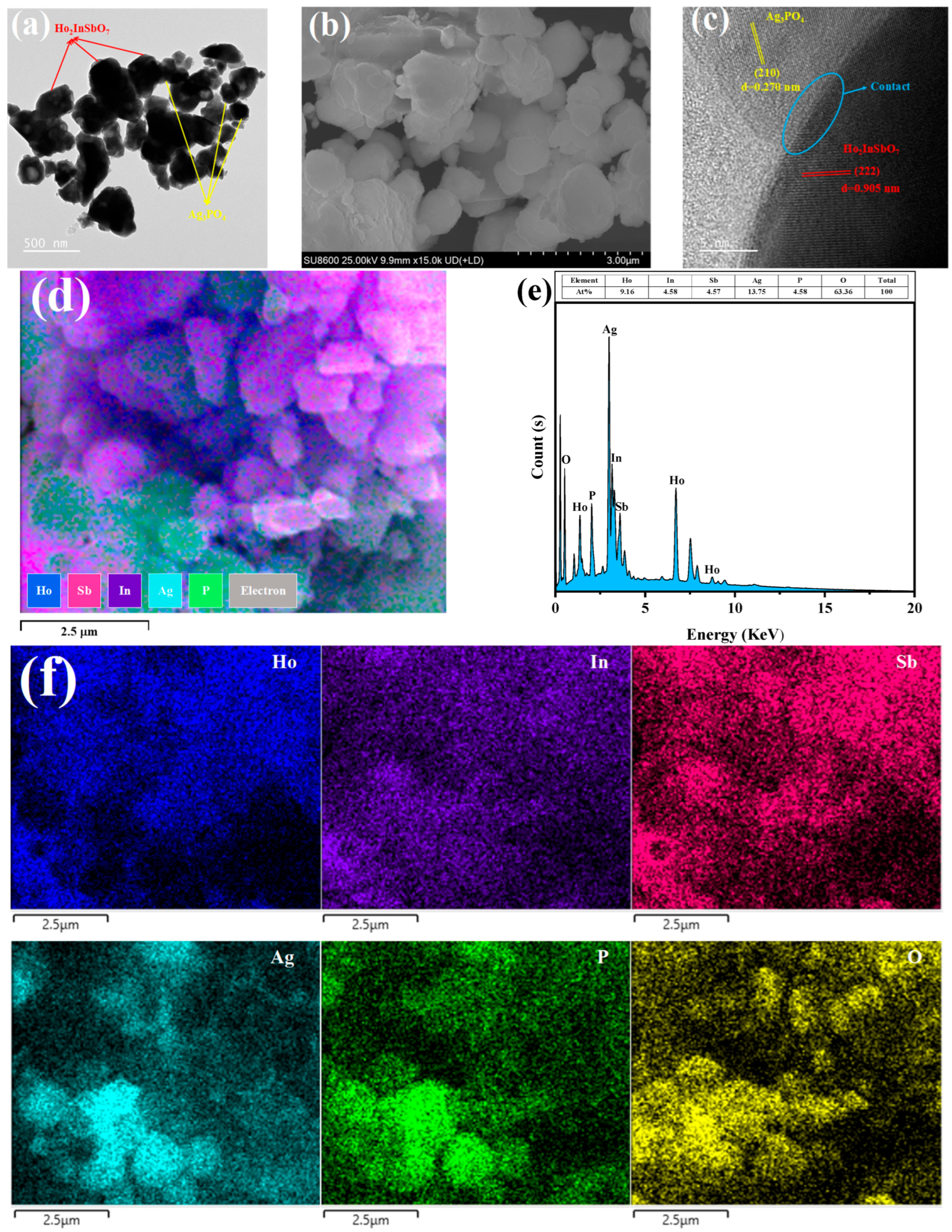


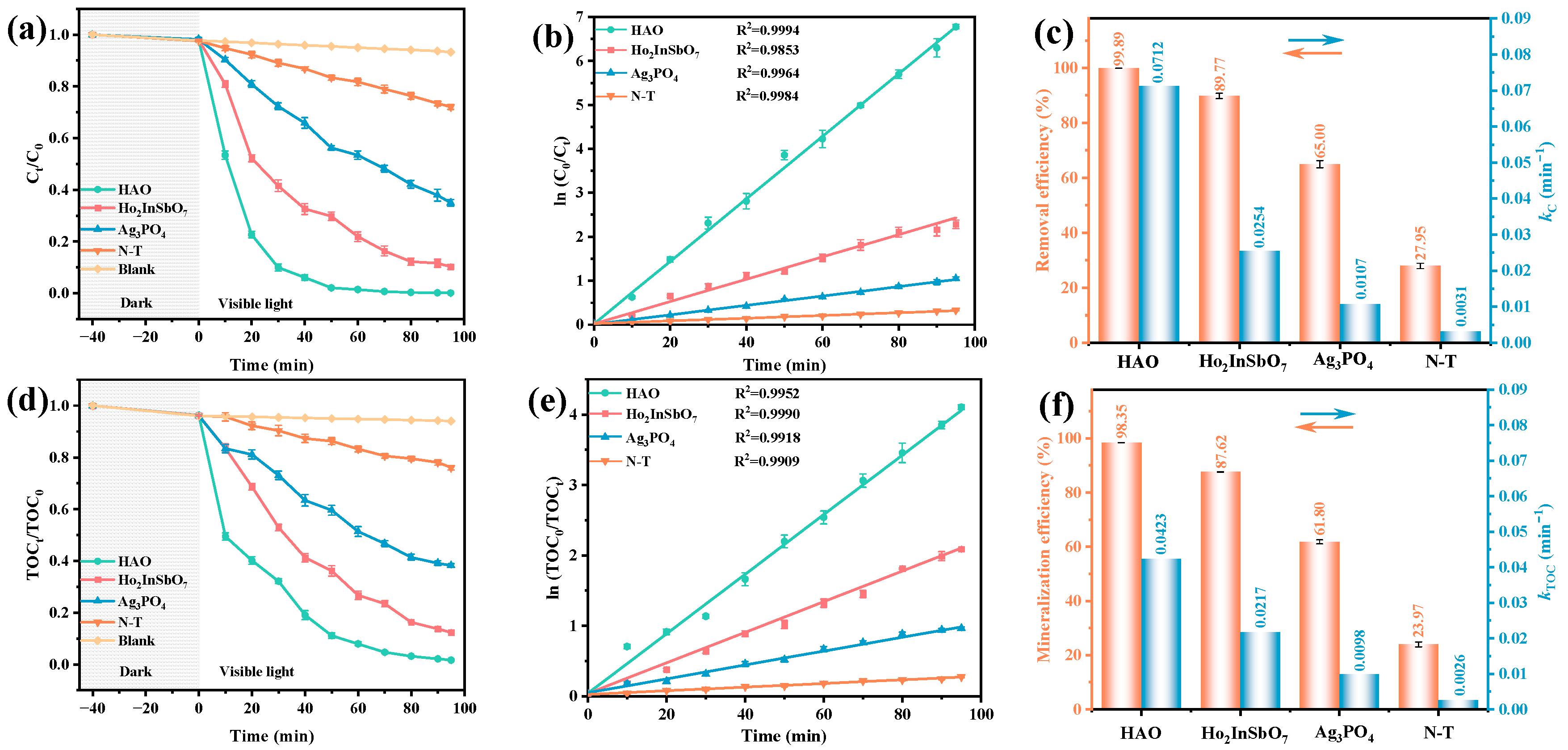
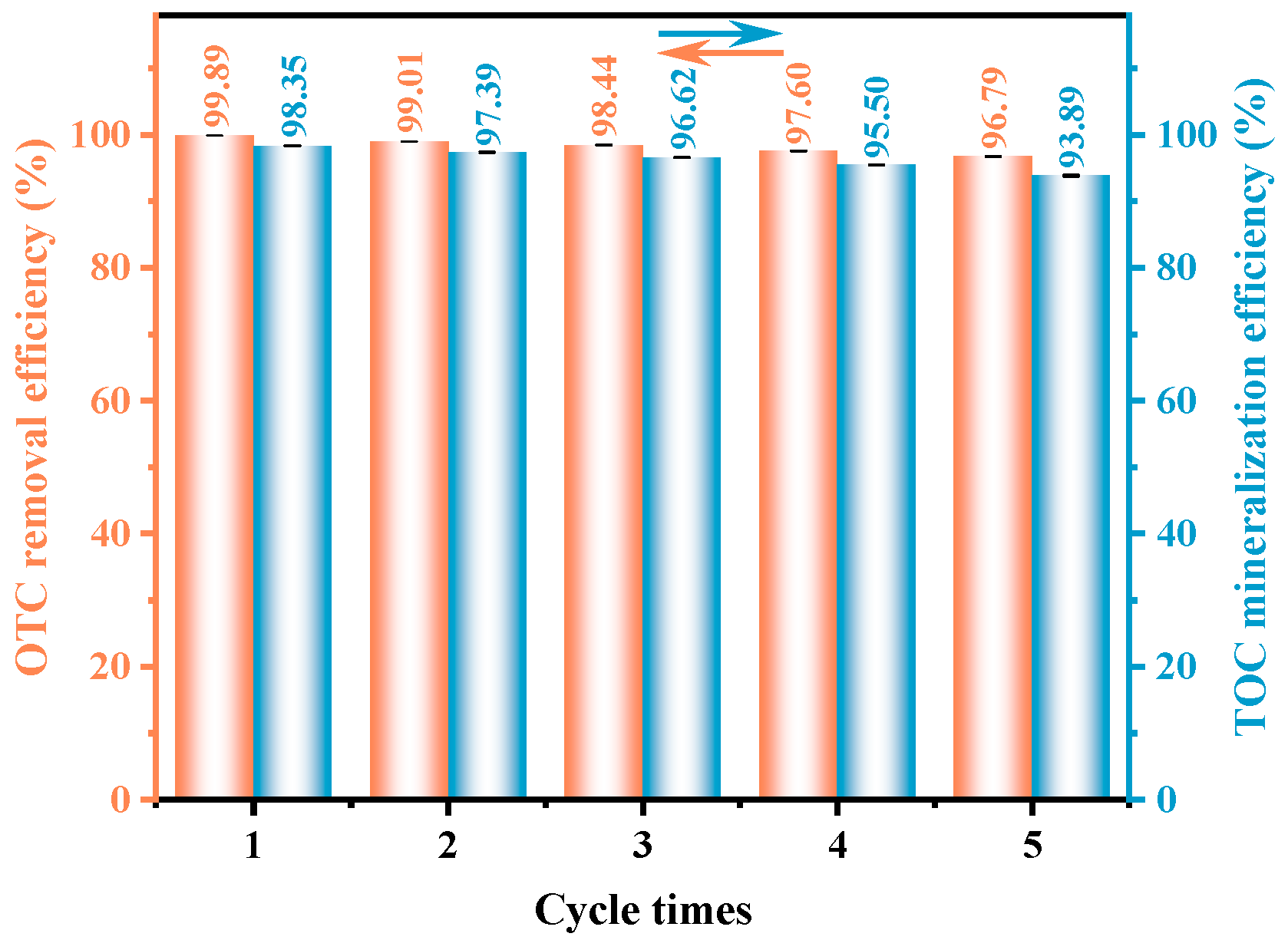

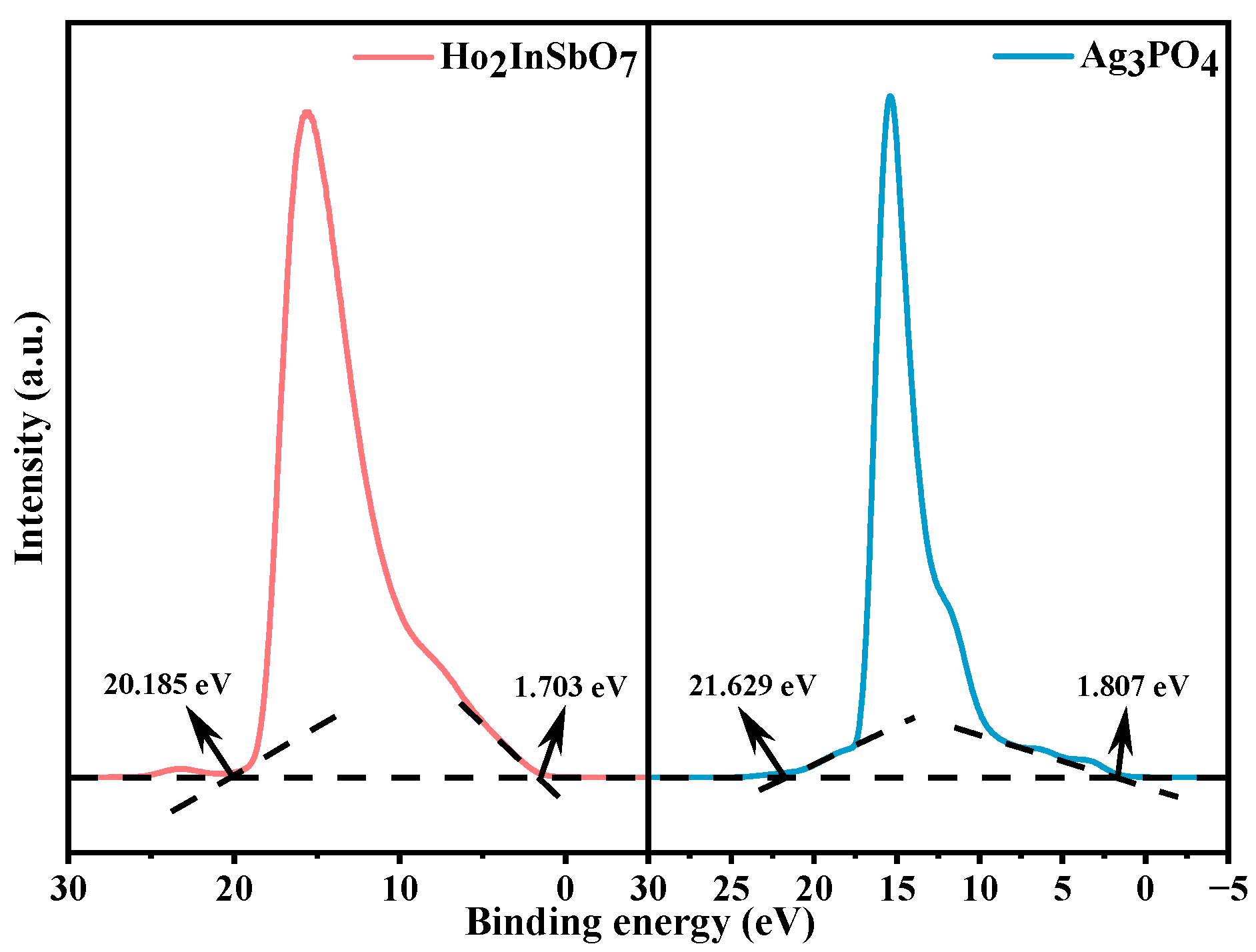

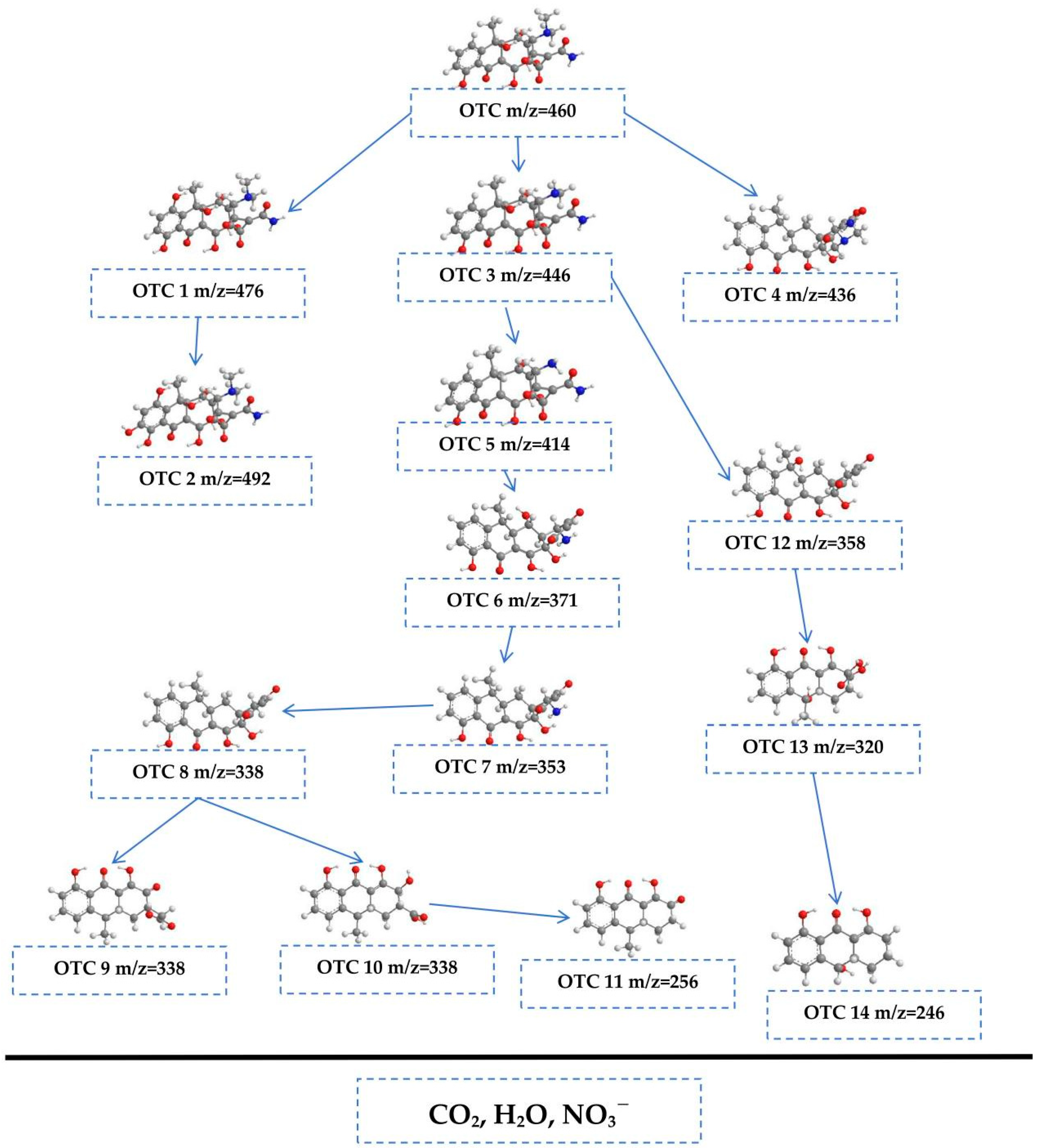
| Photocatalyst | Radiation | Irradiation Time (min) | Antibiotic | Removal Rate (%) | Ref. |
|---|---|---|---|---|---|
| NiCo/ZnO/g-C3N4 | Visible light | 50 | Oxytetracycline | 71.3 | [84] |
| BiVO4 | sunlight conditions | 240 | Oxytetracycline | 83 | [85] |
| CuBi2O4/BiVO4 | Visible light | 60 | Oxytetracycline | 81.11 | [86] |
| NiO/BiOBr | Visible light | 120 | Oxytetracycline | 72.6 | [87] |
| MoS2/UiO-66 | simulated sunlight | 120 | Oxytetracycline | 86.6 | [88] |
| In2S3/Gd2O3 | Visible light | 50 | Oxytetracycline | 80 | [89] |
| Ho2InSbO7 | Visible light | 95 | Oxytetracycline | 89.77 | This study |
| HAO | Visible light | 95 | Oxytetracycline | 99.89 | This study |
Disclaimer/Publisher’s Note: The statements, opinions and data contained in all publications are solely those of the individual author(s) and contributor(s) and not of MDPI and/or the editor(s). MDPI and/or the editor(s) disclaim responsibility for any injury to people or property resulting from any ideas, methods, instructions or products referred to in the content. |
© 2025 by the authors. Licensee MDPI, Basel, Switzerland. This article is an open access article distributed under the terms and conditions of the Creative Commons Attribution (CC BY) license (https://creativecommons.org/licenses/by/4.0/).
Share and Cite
Luan, J.; Zhao, T. Novel Visible Light-Driven Ho2InSbO7/Ag3PO4 Photocatalyst for Efficient Oxytetracycline Contaminant Degradation. Molecules 2025, 30, 3289. https://doi.org/10.3390/molecules30153289
Luan J, Zhao T. Novel Visible Light-Driven Ho2InSbO7/Ag3PO4 Photocatalyst for Efficient Oxytetracycline Contaminant Degradation. Molecules. 2025; 30(15):3289. https://doi.org/10.3390/molecules30153289
Chicago/Turabian StyleLuan, Jingfei, and Tiannan Zhao. 2025. "Novel Visible Light-Driven Ho2InSbO7/Ag3PO4 Photocatalyst for Efficient Oxytetracycline Contaminant Degradation" Molecules 30, no. 15: 3289. https://doi.org/10.3390/molecules30153289
APA StyleLuan, J., & Zhao, T. (2025). Novel Visible Light-Driven Ho2InSbO7/Ag3PO4 Photocatalyst for Efficient Oxytetracycline Contaminant Degradation. Molecules, 30(15), 3289. https://doi.org/10.3390/molecules30153289








